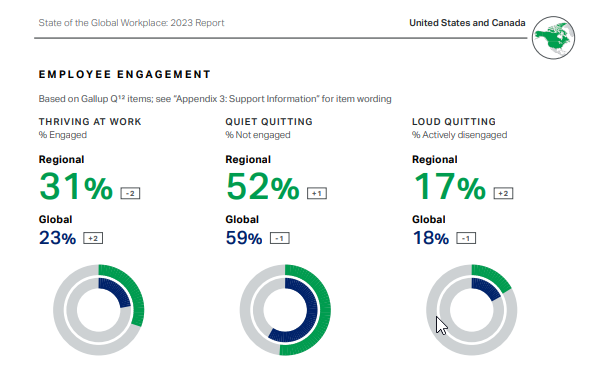According to Gallup’s 2023 State of the Global Workplace Report, employee stress remains at record-level highs especially in the US and Canada.

This report also explores employees’ attitudes toward quiet quitting, thriving at work, remote and hybrid work, and more.
It’s always validating to know you aren’t alone in how you feel though so let’s start with stress at work.
“Forty-four percent of employees said they experienced a lot of stress the previous day, repeating the record high in 2021 and continuing a trend of elevated stress that began almost a decade earlier.” Source: State of the Global Workplace Report
That number jumps to 52% when just looking at employees in the US and Canada. And 57% of females in these two countries experiencing high daily stress which is the highest regional percentage. Go us!

But it’s not all bad news! Employee engagement is increasing again reaching a record-high 23%.
Except a huge jump in engagement in South Asia bolstered that figure. Aaannd engagement in the US and Canada is actually down two points from 2021 to 2022. (To be fair, we are still well above the average with 31% of employees in the US and Canada engaged at work. But this is not a great trend.)
What do you mean by engaged at work?
You may remember from my previous post on The Great Resignation that employee engagement is a measurement of the involvement and enthusiasm of employees and Gallup calculates it by having survey takers rate the following statements (what they call the 12 essential elements of engagement) on a scale from 1-5 with a sixth option of “don’t know/does not apply”:
- I know what is expected of me at work.
- I have the materials and equipment I need to do my work right.
- At work, I have the opportunity to do what I do best every day.
- In the last seven days, I have received recognition or praise for doing good work.
- My supervisor, or someone at work, seems to care about me as a person.
- There is someone at work who encourages my development.
- At work, my opinions seem to count.
- The mission or purpose of my company makes me feel my job is important.
- My associates or fellow employees are committed to doing quality work.
- I have a best friend at work.
- In the last six months, someone at work has talked to me about my progress.
- This last year, I have had opportunities at work to learn and grow.
Other Highlights from the Report
The report also breaks down employees as:
- Thriving: These employees find their work meaningful and feel connected to the team and their organization. They feel proud of the work they do and take ownership of their performance, going the extra mile for teammates and customers.
- Quiet Quitting: These employees are filling a seat and watching the clock. They put in the minimum effort required, and they are psychologically disconnected from their employer. Although they are minimally productive, they are more likely to be stressed and burnt out than engaged workers because they feel lost and disconnected from their workplace.
- Loud Quitting: These employees take actions that directly harm the organization, undercutting its goals and opposing its leaders. At some point along the way, the trust between employee and employer was severely broken. Or the employee has been woefully mismatched to a role, causing constant crises.
In the US and Canada, 31% are thriving, 52% are quiet quitting and 17% are loud quitting. The graph below compares our region with the rest of the world. showing that while we may be more stressed, we are more engaged and less likely to be quiet quitting.
These numbers show there is a lot of room for improvement with how we treat our employees. Need help? Here are some more resources on workplace culture, teams, and relationships:
- Gallup’s full State of the Global Workplace: 2023 Report
- The Great Resignation: Why Your Nonprofit Employees Are Quitting and How to Stop It
- Is Your Team Failing? A Few Reasons Why
- Quiet Quitting Isn’t as Simple as It Seems
- Are Nonprofit Communicators Looking for New Jobs?
- Why Communications Staff Need the Ability to Say No
- More from our blog







